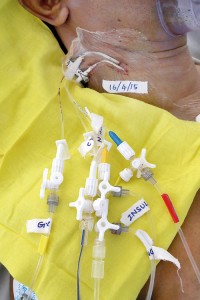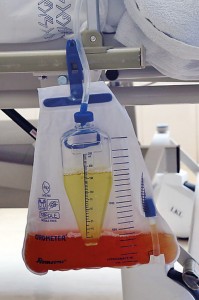Battling HAI: Where special attention is needed
View(s):In the second and final part of ‘Infection control and prevention in health care settings’ which aims to reduce the transmission and acquisition of hospital-acquired infections (HAI), Consultant Microbiologist Dr. Kushlani Jayatilleke attached to the Sri Jayewardenepura Hospital picks out special areas for greater precautions
She reiterates the responsibilities of the Infection Control Teams in hospitals which include:
-Advising staff on all aspects of infection control and maintaining a safe environment for patients and staff
- Providing educational programmes on the prevention of hospital infections for all hospital personnel
- Providing a basic manual of policies and procedures and ensuring that written guidelines based on these are in existence in the hospital
- Establishing systems of surveillance of hospital infection to identify at-risk patients and problem areas that need intervention. Methods for surveillance may include case finding by ward rounds and chart reviews, reviews of laboratory reports and targeted prevalence or incidence surveys
- Advising on the management of patients requiring special isolation and control measures
- Investigating and controlling outbreaks of infection in collaboration with medical and nursing staff
- Ensuring that an antibiotic policy is in existence
- Liaising with the internal doctors and administration (managerial and nursing), community health doctors and nurses and infection control staff at adjacent hospitals

The central lines often used on patients in the ICU. Pix by M.A. Pushpa Kumara
-Performing duties such as kitchen inspections, pest control and waste disposal when required
Underscoring the importance of Standard Precautions which are a set of guidelines that should be followed to reduce the transmission of HAIs, Dr. Jayatilleke says that it is vital for all healthcare workers to follow them at all times when attending to all patients.
These Standard Precautions combine Universal Precautions developed to reduce the risk of blood-borne infections and body substance isolation (BSI) developed to reduce the risk of transmission of resistant pathogens from moist body substances.
Next she deals with the isolation of patients, categorizing it as ‘source isolation’ and ‘protective isolation’:
Source isolation –
- Airborne precautions (such as in the case of tuberculosis) should include placing the patient in a private room with monitored negative air pressure in relation to the corridor, with 6 to 12 air changes per hour, exhaust air directly outside or re-circulated air filtered by a high efficiency particulate air filter. If a private room is not available, the patient may be placed with other patients having the same infection, while ensuring the use of dedicated equipment such as stethoscopes, disposable blood pressure cuffs, disposable thermometers, etc.
A high efficacy mask should be worn when entering the patient’s room and removed when leaving it, with the mask being disposed of in a clinical waste container. Disposable masks should be discarded after 4-6 hrs of use, while a patient’s mask may be re-used by the patient.
When splashing is expected, eye protection such as goggles or face shields should be worn.
If patient movement or transport is necessary, the patient should be given a surgical mask.
- Droplet precautions (such as in the case of influenza) also include placing the patient in a private room with the same precautions as above.
Wear a surgical mask when entering the patient’s room or when working within three feet of the patient. Remove the mask when leaving the patient’s room and dispose of it in a waste container. Disposable masks should be discarded after 4-6 hrs of use, while the patient’s mask may be reused by the patient.
Eye protection (goggles or face shields) should be worn for procedures with the risk of splash to the eye, within three feet of the patient.
If patient movement or transport is necessary, have the patient wear a surgical mask, if possible.
Meanwhile contact precautions (such as in the case of Methicillin-resistant Staphylococcus aureus — MRSA) should include the patient being placed in a single room with healthcare workers wearing disposable water impermeable aprons when entering the room; donning gloves and masks when necessary; strict hand-washing practice before attending to the patient and when leaving the room, if the patient is in protective isolation
As the above-mentioned ideal conditions are not available at all times in most of the hospitals, a risk-assessment should be performed on individual patients, with the management being modified based on those results.
Referring to infection control in special care units, Dr. Jayatilleke picks out operating theatres, intensive care units (ICUs) and labour rooms.
In the operating theatre:
- The operating suite and equipment — theatre design including the lay-out (sterile area, clean area and dirty area); ventilation (air-flow velocity and direction from ‘sterile’ to less clean to dirty areas/filters); properly-closing doors; floor and surfaces easy to clean; storage of equipment; sterilization of equipment; cleaning of the operating suite; disinfection of anaesthetic apparatus and mechanical ventilation; separate rooms for

Drainage bags should be changed or emptied twice daily
‘clean’ and ‘septic’ cases/order of operation/cleaning in-between patients; filter connected to suction apparatus to prevent contamination by infective aspirates; measures to prevent contamination of disinfectants and other fluids; and precautions to prevent infections transmitted through blood
- Preparation of the surgical team — theatre discipline; the team (‘scrubbed’ and ‘unscrubbed’) should be kept as small as possible; no one whose presence is not essential should be admitted to the operating room; restrict movement and conversation; scrubbed staff should not touch any other area other than the surgical site and sterile drapes; surgical team should not have any septic lesions (covering with adhesive dressings may not be enough) or respiratory infections or Streptococcal pyogenes sore throat or Hep B if possible; removal of everyday clothing is recommended; the clothing in the operating theatre should be a barrier to bacteria and other particles
Footwear with impervious soles should be worn in the sterile zone and should fit well; mats at the entrance not recommended; headgear and masks are recommended for the operating team, with the masks covering the nose and the mouth; remove all jewellery before scrubbing; nail brush should be used only for the first hand wash of the day to remove debris from underneath nails; apply 3-5 ml of antiseptic detergent to hands and forearms and scrub for 3-5 minutes (for the first case) to cover all areas of the hands and forearms (in between cases, scrubbing should last for only 2-3 minutes); do not use brushes; hands should be held high while washing with water.
- Preparation of the patient — fitness of the patient for the operation; protection against ‘self-infection’; protection of the operation site (showering and disinfection); wearing freshly washed clothes immediately before being sent to the theatre; sterile drapes to cover the area; bowel preparation in bowel surgery; and chemoprophylaxis (antibiotics given in certain surgeries at the time of the procedure to prevent infection).
- Performance of the operation — tissue handling technique; wound drainage used only when indicated as it increases the risk of infection; and proper disposal of waste.
In the ICU:
- Design of the unit — isolation rooms/cubicles; adequate space (10-12 feet between bed centres); mechanical ventilation with 10 air changes/hour; and floors and walls should be washable
- Furniture and fittings — furniture should be minimal; monitoring equipment should be clear of the floor and easily movable and cleaned; and suction apparatus and sphygmomanometers should be wall-mounted but detachable
- Cleaning of environment — as in wards; should have a written protocol; daily, weekly and routine cleaning should be methodical
- Handling of patients – aseptic care; hand washing essential; non-sterile gloves for bronchial and oral toilet; non-essential visiting should be discouraged; gowns or plastic aprons should be worn when handling the patient and changed after caring for each patient.
- Procedures — hand washing is most important before aseptic procedures such as insertion and handling of intravenous catheters and urinary cathters; care in tracheostomy and endotracheal intubation, with non-sterile plastic gloves being worn and hand washing important; in mechanical ventilators bacterial filters should be changed between patients and the ventilator/patient circuits and humidifiers should be autoclaved; and when using urinary catheters, the drainage bags should be changed or emptied twice daily under aseptic conditions.
- Equipment — all equipment should be clean and dry.
- Antibiotic prophylaxis — better avoided as resistant organisms are selected.
In the labour room:
- Design — adequate hand-washing facilities; soap and running water/elbow operated taps/single-use towels for drying; adequate space between beds; good ventilation; and antiseptic solutions such as alcohol hand-rub should be available.
- Cleaning of environment — there should be a cleaning protocol; and blood spills should be cleaned using 1% hypochlorite (following the proper method)
- Handling of patients — aseptic technique should be used; and hand washing before examining or delivering a baby or placenta should be practised.
- Procedures — aseptic techniques and hand washing.
- Equipment – proper sterilization and disinfection are important based on a guideline; care should be taken when storing things (sucker tubes); and handling.


